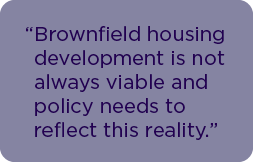What will drive property markets in 2024?
Growth, interest rates and inflation
The UK narrowly avoided recession in 2023 and on current projections should do so again in 2024, with quarterly GDP growth expected to range between zero and +0.2% during the year. 2024 as a whole is forecast to see growth of just 0.3%-0.4%, contrasting with an average of 1.6% per annum over the previous decade and 2% per annum over the past 30 years.

14 interest rate rises dominated the economic story of the last two years (from just 0.1% to 5.25%), as the Bank of England has put the brakes on economic growth to control soaring inflation. CPI peaked in late 2022 at more than 11% but has now dropped below 5%, and most forecasters expect CPI to fall further to around 2.5% by Q4 2024, close to the Bank of England’s 2% target. However, this will depend on whether wage growth can be contained (it is currently nearly 8%), and on global energy prices remaining stable (geopolitics in the Middle East and Russia, the severity of Europe’s winter weather, and global energy demand all have the potential to cause energy price turmoil).
Nevertheless, we know that energy costs will continue to be higher compared with pre-2022 prices, and whilst this will clearly constrain economic growth and household spending, a positive side effect will be to further encourage the transition towards renewable energy.
Although interest rates will remain elevated throughout 2024, the markets expect the next move in Bank Rate to be down rather than up, which is a positive for investor sentiment. The first downward move is not likely to be until the second half of the year - the Bank of England will not want to cut interest rates too early, risking a reignition of inflation – but this would likely occur earlier if the economy stalls further and enters recessionary territory.
A tight labour market
The UK labour market will continue to cool in 2024, with almost no change to the overall number in employment – contrasting sharply with the average net increase of 300,000 per annum over the last decade (although with huge swings around the pandemic).
The unemployment rate is forecast to edge up by around 0.3% during 2024, but will remain low by historical standards. The labour market will remain tight in many sectors and locations, and this will maintain upward pressure on wages. Whilst this is positive for household finances, it will hamper the fight against inflation, and act a constraint on commercial property occupier demand.
Politics – all change?
2024 will almost certainly be a general election year - it could technically be held as late as 25th January 2025, but autumn 2024 appears the most likely timing. A Labour majority looks almost inevitable, based on opinion polls (the average Labour lead over the Conservatives in polls conducted over the last month is 20 points) and recent by-election results (with three recent by-elections showing a swing of more than 20% to Labour). However, it is worth remembering the quotation that a week is a long time in politics.

Housing will be a key election issue, as will levelling up (again), and we hope the election will bring greater clarity around the future shape and financing of the planning system. Sustainability policies, too, are much contingent on the election outcome. Labour may well take a very different position to the current government on many issues, potentially strengthening climate targets in contrast to the recent Conservative row-back on climate policies.
Shifting demand, delivering supply
Although 2024 is likely to see muted economic and employment growth at best, property markets will continue to be driven by the changing nature of demand rather than the quantum of it.
On the retail side, the evolution of online shopping will continue to create huge demand for urban logistics and open storage space in excess of supply.

Key amongst these drivers is the structural undersupply of housing, senior living and healthcare property, against a population that is both growing and ageing. Indeed, in 2024 alone, projections suggest that the population will rise by approximately 300,000, and that there will be 180,000 more people over the age of 75. Over the next decade, these figures are 1.7 million and 950,000 respectively.
The rural land market is also seeing huge change, as evolving natural capital markets bring an increasing array of purchases to the market, accelerated by the introduction of mandatory Biodiversity Net Gain this year.
These uses will continue to contrast with more uncertain demand for retail and office space and the flight to quality, with commercial property demand focussed ever more tightly on the best located, best quality space.
For many property markets, the key constraint will be supply rather than demand, ranging from labour shortages in the construction industry, to a lack of the electricity grid capacity needed to service new residential and commercial development, ever increasing data centre demand and the rise of electric road vehicles.
Government policy will be instrumental in alleviating many of these bottlenecks. With attention increasingly turning to the general election, politics rather than economics may well be the key market driver in 2024.




 BNG requirements prior to the implementation date, and some are exploring higher percentages of net gain than the 10% prescribed. We are increasingly seeing LPAs deviating from the national position, either in the percentage net gain required or in their guidance for delivery. We are also seeing more LPAs adopting measures to channel investment towards local sites to accelerate the local market. We expect that the year ahead will bring even more creative and resourceful local solutions.
BNG requirements prior to the implementation date, and some are exploring higher percentages of net gain than the 10% prescribed. We are increasingly seeing LPAs deviating from the national position, either in the percentage net gain required or in their guidance for delivery. We are also seeing more LPAs adopting measures to channel investment towards local sites to accelerate the local market. We expect that the year ahead will bring even more creative and resourceful local solutions.

 Brownfield housing development is not always viable and policy needs to reflect this reality. It is positive that Labour has recognised the potential of the low-quality, mostly brownfield, ‘grey belt’ that is unnecessarily protected through green belt allocation. In any case, there is nowhere near sufficient brownfield land to meet the 300,000 figure, certainly across multiple years, and meaningful greenfield development will be integral to increasing the rate of delivery.
Brownfield housing development is not always viable and policy needs to reflect this reality. It is positive that Labour has recognised the potential of the low-quality, mostly brownfield, ‘grey belt’ that is unnecessarily protected through green belt allocation. In any case, there is nowhere near sufficient brownfield land to meet the 300,000 figure, certainly across multiple years, and meaningful greenfield development will be integral to increasing the rate of delivery.







